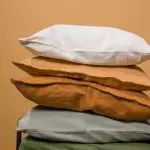Are you looking to give your leather chairs a fresh new look? In this article, we will show you how to cover your leather chairs with fabric, transforming them into stylish and comfortable pieces of furniture.
You’ll learn the step-by-step process of:
- Choosing the right fabric
- Preparing the chair
- Measuring and cutting the fabric
- Attaching it securely
- Finishing the edges for a professional look.
Get ready to revamp your leather chairs and add a touch of personal style to your home.
Table of Contents
Choosing the Right Fabric
When choosing the right fabric for covering leather chairs, it’s important to consider durability and color options.
Fabric selection plays a crucial role in transforming the look and feel of your leather chairs. Opt for a fabric that is durable and can withstand regular use. Look for materials like microfiber or polyester blends, which are known for their strength and resistance to wear and tear. These fabrics are also easy to clean and maintain, making them ideal for busy households.
Additionally, consider the color coordination of the fabric with your existing decor. Choose a color that complements or contrasts with the leather, depending on the desired effect. For a cohesive look, select a fabric that matches the color scheme of your room. On the other hand, if you want to make a bold statement, choose a fabric in a contrasting color to create a focal point. Keep in mind that neutral shades like gray, beige, or cream are versatile and can easily blend with different styles and color palettes.
Take the time to explore various fabric options and consider the durability and color coordination to find the perfect fabric for covering your leather chairs.
Preparing the Leather Chair
To get started, you’ll want to first ensure that your leather chair is properly cleaned and free of any dust or debris. Cleaning leather is essential before you cover it with fabric, as any dirt or grime can affect the adhesion of the new fabric.
Begin by vacuuming the chair with a brush attachment to remove loose dirt and dust. Then, using a damp cloth and a mild leather cleaner, gently wipe down the entire surface of the chair. Be sure to follow the manufacturer’s instructions for the cleaner and avoid using harsh chemicals that could damage the leather. If there are any stains or spills on the chair, you may need to use a specialized leather stain remover.
Once the chair is clean, allow it to dry completely before moving on to the next step.
In addition to cleaning, it’s also important to inspect the leather for any signs of damage or wear. If you notice any tears, scratches, or discoloration, you may want to consider repairing the leather before covering it with fabric. There are leather repair kits available that include everything you need to fix minor damage. Simply follow the instructions provided with the kit to mend the leather. For more extensive damage, it may be best to consult a professional leather repair service.
Taking the time to properly clean and repair your leather chair will ensure a smooth and successful fabric covering process.
Measuring and Cutting the Fabric
When it comes to covering your leather chair with fabric, there are a few key points to keep in mind.
First, proper fabric measurements are crucial to ensure a seamless fit. Taking accurate measurements will help you avoid any unnecessary fabric wastage or ill-fitting covers.
Second, precision in cutting is essential to achieve clean and straight edges, which will contribute to the overall professional look of your chair.
Lastly, choosing suitable materials is important to ensure durability and longevity of the fabric cover. Consider factors such as the chair’s usage, desired aesthetic, and ease of maintenance.
Proper Fabric Measurements
You’ll need accurate fabric measurements to properly cover your leather chairs. When choosing fabric for your chair, consider the type of fabric and the pattern that will best suit your style and needs.
There are various fabric types to choose from, such as cotton, linen, polyester, and velvet. Each fabric type has its own characteristics and benefits, so make sure to select one that is durable and easy to clean.
Additionally, consider the fabric pattern that will complement your room’s decor. Whether you prefer solid colors, stripes, floral prints, or geometric designs, choose a pattern that will enhance the overall aesthetic of your space.
Taking precise measurements and selecting the right fabric type and pattern are crucial steps to ensure a successful chair cover project.
Precision in Cutting
Be precise when cutting the material to ensure accurate measurements for your chair project. Cutting techniques play a crucial role in achieving a professional-looking result. Here are some tips to help you master the art of precise cutting:
- Use a sharp pair of fabric scissors to ensure clean and accurate cuts.
- Take your time and measure twice before making any cuts to avoid mistakes.
- Mark your fabric with chalk or fabric pens to guide your cuts.
- Consider the pattern of your fabric when cutting to ensure proper alignment and symmetry.
- Practice cutting on scrap fabric first to familiarize yourself with the technique.
Fabric selection is also important when covering leather chairs. Choose a durable fabric that complements the style of your chair and can withstand regular use. Keep in mind the color and texture to create a cohesive look. With precise cutting techniques and thoughtful fabric selection, you can transform your leather chairs into stunning pieces that reflect your personal style.
Choosing Suitable Materials
To ensure a successful chair project, it’s important to choose materials that are suitable for the task at hand. When it comes to covering leather chairs with fabric, there are a few key considerations to keep in mind.
First, think about the upholstery technique you’ll be using. If you plan on stapling the fabric directly onto the chair, you’ll need a sturdy and durable material that can withstand the tension.
Additionally, consider the fabric pattern. Opt for a design that complements the overall aesthetic of the room and matches your personal style. Whether you choose a bold print or a subtle texture, make sure it harmonizes with the existing decor.
Attaching the Fabric to the Chair
When it comes to attaching fabric to your chair, there are several techniques you can use. Some popular options include stapling, sewing, or using adhesive.
It’s important to consider the compatibility of the fabric with the chair material to ensure a long-lasting and durable attachment.
While you can certainly tackle this project on your own, it’s worth considering the benefits of hiring a professional to ensure a flawless and expertly executed result.
Fabric Attachment Techniques
There are various techniques for attaching fabric to leather chairs. Here are four methods to consider:
-
Fabric Stretching: Start by securing the fabric to the chair frame using staples or tacks. Then, gradually stretch the fabric over the chair’s surface, ensuring a smooth and wrinkle-free finish. Secure the fabric in place with additional staples or tacks.
-
Fabric Adhesive: Apply a fabric adhesive to the back of the fabric and press it firmly onto the chair’s surface. Smooth out any wrinkles or bubbles, ensuring a secure bond. Allow the adhesive to dry completely before using the chair.
-
Upholstery Pins: Use upholstery pins to secure the fabric to the chair. Insert the pins at regular intervals along the edges, making sure to catch both the fabric and the leather underneath. This method provides a temporary attachment and allows for easy removal or repositioning of the fabric.
-
Sewing: If you have sewing skills, you can sew a slipcover for your leather chair. Measure and cut the fabric to fit the chair’s dimensions, then sew the pieces together to create a snug and tailored cover. Attach the slipcover to the chair using hooks, ties, or Velcro.
These techniques provide different options for attaching fabric to leather chairs. Choose the method that best suits your skills and preferences.
Material Compatibility Considerations
Now that you know the various fabric attachment techniques, let’s move on to the next step – material compatibility considerations.
When covering leather chairs with fabric, it is crucial to select the right type of fabric that complements the leather and ensures a seamless look.
Firstly, consider the weight and durability of the fabric. Since leather chairs are often subjected to regular use, choose a fabric that is sturdy and can withstand wear and tear. Additionally, opt for a fabric that is easy to clean, as spills and stains are bound to happen.
Secondly, think about the color and pattern of the fabric. Select a color that complements the leather and the overall aesthetic of the room. If you want to add some visual interest, go for a patterned fabric that enhances the chair’s appearance.
Professional Vs. DIY Options
If you want a seamless result, you should consider the professional versus DIY options for transforming your leather chairs. While DIY can be cost-effective, professional services offer expertise and a polished finish. Here’s a cost comparison to help you decide:
| Option | Cost | Pros | Cons |
|---|---|---|---|
| DIY | Low | Cost-effective | Requires time and effort |
| Professional | High | Expertise and skill | Expensive |
DIY options allow you to save money, but they require you to invest time and effort into learning the necessary skills. On the other hand, professional services may be more expensive, but they guarantee a high-quality result. Professionals have the expertise and skill to transform your leather chairs into beautifully upholstered pieces. Consider your budget, time availability, and desired outcome when making your decision.
Securing and Finishing the Edges
To secure and finish the edges, you’ll need to use a sewing machine or hand stitch the fabric in place on your leather chairs. There are several finishing techniques you can use to ensure a professional and polished look for your newly covered chairs.
One alternative method to sewing is using fabric glue. Fabric glue can be a convenient option for those who don’t have access to a sewing machine or are not confident in their stitching skills. Simply apply the fabric glue along the edges of the fabric and press it firmly onto the leather. However, keep in mind that fabric glue may not provide the same level of durability as stitching, so it’s important to choose a high-quality adhesive.
Another alternative method is using decorative trim or upholstery tacks to secure the fabric in place. This can add a decorative touch to your chairs while also providing a secure finish. To use decorative trim, simply glue or stitch it along the edges of the fabric. Upholstery tacks can be hammered into the chair’s frame, securing the fabric tightly.
Care and Maintenance Tips
Regularly cleaning and conditioning your fabric-covered leather chairs will help to maintain their appearance and extend their lifespan. Taking care of your chairs is essential to prevent damage and ensure they continue to look their best.
Here are some tips to keep in mind:
- Firstly, vacuum your fabric-covered leather chairs regularly to remove any dust or dirt that may accumulate. Use a soft brush attachment to avoid scratching the surface of the fabric.
- Additionally, be sure to address any spills or stains immediately. Blot the area with a clean cloth or paper towel to absorb as much of the liquid as possible, then use a mild fabric cleaner to treat the stain.
In terms of conditioning, it’s important to use a leather conditioner specifically designed for fabric-covered leather. Apply the conditioner according to the manufacturer’s instructions, using a clean cloth or sponge. This will help to keep the fabric soft and supple, preventing it from drying out and cracking over time.
Lastly, avoid placing your fabric-covered leather chairs in direct sunlight or near heat sources, as this can cause the fabric to fade or shrink. Additionally, keep sharp objects away from the chairs to prevent any accidental tears or punctures.
Conclusion
In conclusion, covering leather chairs with fabric is a great way to give them a new look and extend their lifespan. By choosing the right fabric, properly preparing the chair, and carefully measuring and cutting the fabric, you can achieve a professional-looking result.
Attaching the fabric securely and finishing the edges will ensure a neat and polished appearance. Remember to follow care and maintenance tips to keep your newly covered chairs looking their best for years to come.
So go ahead, transform your leather chairs with fabric and enjoy the refreshed and updated look they bring to your space.
- Reducing Fabric Waste: New Innovations - July 20, 2024
- Lifecycle of Eco-Friendly Fabrics Explained - July 20, 2024
- Sustainable Fabric Production Techniques - July 20, 2024





